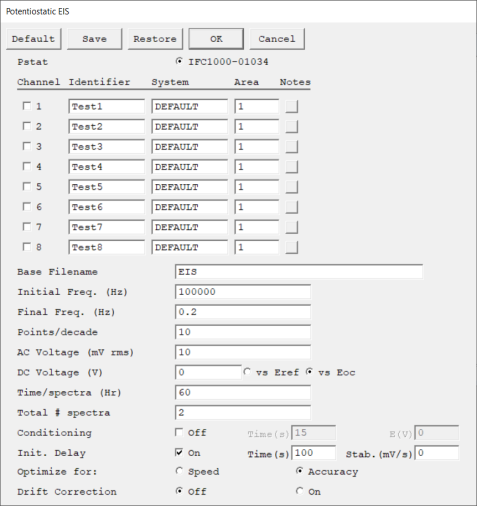
Multiplexed Potentiostatic EIS Repeating Sequential can be understood as a combination of the Potentiostatic EIS Repeating and Multiplexed Potentiostatic EIS techniques.
This is typical Setup window:

The Setup window looks similar to that for Potentiostatic EIS. In addition, there is a table for choosing the eight multiplexer channels. This is similar to the Channel Setup in a script such as Multiplexed RpEc Trend. See a description of the multiplexer table.
Time/spectra is used to input the time interval between the start of the spectra. The units are hours. The Time/spectra parameter must be a time longer that the time required to acquire spectra on all the active Channels. You can estimate this time as follows:
For one spectrum, assuming the lowest frequency is less than 10 Hz, the Optimize for parameter is set to the Normal radio button, and there are 10 points per decade, you can approximate the time required from the total number of points, N, and the lowest frequency Flow.
Spectrum acquisition time = Init. Delay + 2.5 seconds × N + 16 / Flow
The estimated time to measure a spectrum from 10 kHz to 0.1 Hz (with a 10 s Init. Delay) is 297.5 s or about 5 min.
The total time to record the spectra is the number of active Channels times the Spectrum acquisition time. In our example with two channels and 297.5 seconds, the time to acquire the spectrum is approximately 10 min.
If you want to record the spectrum described above on two channels, we recommend you set the Time/spectra parameter at least twice the estimate. Once every 20 minutes seems reasonable, so you can set the Time/spectra parameter for 0.3333 hours (or longer).
Each spectrum is stored in a separate data file. The filename is complex. It is a concatenation of the Base Filename entered in Setup, the multiplexer Channel, and Run number. If the Base Filename entered in Setup is Mux EIS Repeating, the first spectrum in Channel 1 is in Mux EIS Repeating1_Run1.DTA, Channel 2’s spectrum is in EIS Repeating2_Run1.DTA, etc. The second spectra on the channels are in Mux EIS Repeating1_Run2.DTA and EIS Repeating2_Run2.DTA, … etc.
The EIS spectra can be plotted and analyzed in our Echem Analyst™. Overlaying the EIS spectra from the multiple “runs” can be useful.